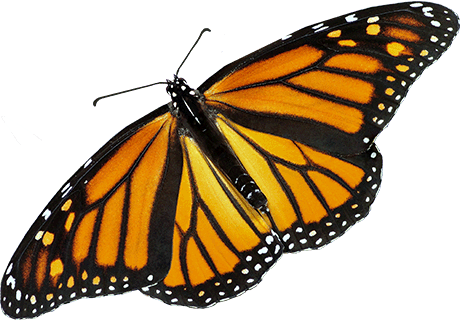
Protecting
Pollinators
These pollinators are listed under the Committee on the Status of Endangered Wildlife in Canada (COSEWIC) and the Government of Canada’s Species at Risk
Yellow-Banded Bumble Bee (Bombus terricola)
Special Concern
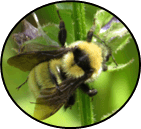 This exceptional pollinator was broadly distributed across the northeastern US and southern Canada, until populations and ranges began decreasing in the 1990s. It is one of the earliest bumble bee species to emerge in the spring, and thus pollinated early blooming wildflowers and agricultural crops, such as apple and cranberry. A combination of factors may have contributed to this species’ decline, such as pathogen spillover from commercial bees, as well as climate change – a factor that causes a shift in range for many animals.
This exceptional pollinator was broadly distributed across the northeastern US and southern Canada, until populations and ranges began decreasing in the 1990s. It is one of the earliest bumble bee species to emerge in the spring, and thus pollinated early blooming wildflowers and agricultural crops, such as apple and cranberry. A combination of factors may have contributed to this species’ decline, such as pathogen spillover from commercial bees, as well as climate change – a factor that causes a shift in range for many animals.
Rusty-Patched Bumble Bee (Bombus affinis)
Endangered
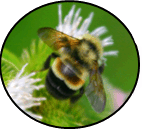 Once common in eastern North America, this species has experienced a serious loss since the 1980s, with very few sightings in the new millennium. Although the exact cause for the decline is uncertain, suspected threats to the Rusty-Patched Bumble Bee include pesticide use (neonicotinoids), and habitat loss. Diseases carried by commercially reared bees used to pollinate crops is also considered to be a large threat.
Once common in eastern North America, this species has experienced a serious loss since the 1980s, with very few sightings in the new millennium. Although the exact cause for the decline is uncertain, suspected threats to the Rusty-Patched Bumble Bee include pesticide use (neonicotinoids), and habitat loss. Diseases carried by commercially reared bees used to pollinate crops is also considered to be a large threat.
This species is currently protected under the federal Species at Risk Act (SARA).
Gypsy Cuckoo Bumble Bee (Bombus bohemicus)
Endangered
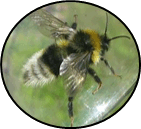 This species had one of the largest ranges of all bumble bees, spanning most of Canada and the northern United States. It is a nest parasite of the Rusty-Patched and Yellow-Banded Bumble Bees, who are also experiencing severe declines. With the loss of its hosts, the Gypsy Cuckoo population continues to decrease. Over a 13 year study of over 6,000 bumble bees, only one Gypsy Cuckoo Bumble Bee was found in Ontario.
This species had one of the largest ranges of all bumble bees, spanning most of Canada and the northern United States. It is a nest parasite of the Rusty-Patched and Yellow-Banded Bumble Bees, who are also experiencing severe declines. With the loss of its hosts, the Gypsy Cuckoo population continues to decrease. Over a 13 year study of over 6,000 bumble bees, only one Gypsy Cuckoo Bumble Bee was found in Ontario.
Monarch Butterfly (Danaus plexippus)
Endangered
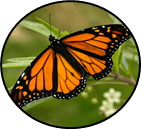 The instantly recognizable Monarch Butterfly is losing much of its natural habitat, especially its host plant, the Milkweed. Monarch caterpillars feed exclusively on Milkweed leaves until they are ready for metamorphosis. During the annual Monarch migration to Mexico, stops are made along the way for feeding and breeding; however residential development and widespread herbicide use all over North America is threatening Monarch habitat both in their native ranges, and on their way to overwintering sites.
The instantly recognizable Monarch Butterfly is losing much of its natural habitat, especially its host plant, the Milkweed. Monarch caterpillars feed exclusively on Milkweed leaves until they are ready for metamorphosis. During the annual Monarch migration to Mexico, stops are made along the way for feeding and breeding; however residential development and widespread herbicide use all over North America is threatening Monarch habitat both in their native ranges, and on their way to overwintering sites.
This species is currently protected under the federal Species at Risk Act (SARA).
Karner Blue Butterfly (Plebejus melissa samuelis)
Extirpated
 This butterfly can no longer be found in the wild in Canada, as its habitat and main larval food source virtually disappeared. This species relies on the Wild Lupine as a host plant for its caterpillar stage before turning into an adult butterfly (which only live for about 5 days!). Wild Lupine requires sunny, open areas, such as savannahs, to grow. They often thrive after wild fires, which eliminate shady overgrowth. The loss of this type of ecosystem can be attributed to residential development, wildfire suppression, increased shady tree plantings, and abundant deer populations that also feed on Wild Lupine. The scarce Wild Lupine population has resulted in the extirpation of the Karner Blue, despite efforts to repopulate the plant; however, recovery efforts have been taken to reintroduce the Karner Blue to Canada. If populations of its host plant can be restored, the Toronto Zoo is poised to aid in a conservation breeding program to reintroduce the Karner Blue to Ontario.
This butterfly can no longer be found in the wild in Canada, as its habitat and main larval food source virtually disappeared. This species relies on the Wild Lupine as a host plant for its caterpillar stage before turning into an adult butterfly (which only live for about 5 days!). Wild Lupine requires sunny, open areas, such as savannahs, to grow. They often thrive after wild fires, which eliminate shady overgrowth. The loss of this type of ecosystem can be attributed to residential development, wildfire suppression, increased shady tree plantings, and abundant deer populations that also feed on Wild Lupine. The scarce Wild Lupine population has resulted in the extirpation of the Karner Blue, despite efforts to repopulate the plant; however, recovery efforts have been taken to reintroduce the Karner Blue to Canada. If populations of its host plant can be restored, the Toronto Zoo is poised to aid in a conservation breeding program to reintroduce the Karner Blue to Ontario.
This species is currently protected under the federal Species at Risk Act (SARA).













